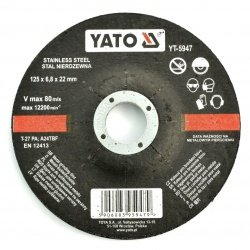Each device powered by any energy source is characterized by a parameter called energy efficiency, which determines the extent to which in a given process the energy supplied in it is converted into output energy. A thermoelectric cooling cell is composed of a layer of semiconductors sandwiched between two ceramic electrodes in a similar way to the electrodes separated by a dielectric, which are a simple electrical capacitor. Peltier cells It is used in various applications, such as cooling processors in computers and as thermoelectric voltage sources. The Peltier modules offered by the Botland store operate on the principle of a small heat pump. By connecting a DC power source to the module cladding, heat is transferred from one cladding to another. This creates a temperature difference. Peltier cells are often used e.g. in industrial applications, portable fridge-freezers, electromedical equipment, as well as in measuring instruments.
Moduły Peltiera (ogniwa)
Peltier Cell TEC1-12708 12V / 8A
The cooling cell applied, for example, in portable refrigerators. It is supplied with the voltage up to 12 V, it consumes up to 8 A of current. Board sizes - 40 x 40 x 3.6 mm.Peltier Cell TEC1-12715 12V / 12A
The cooling cell applied, for example, in portable refrigerators. It is supplied with the voltage up to 12 V, it consumes up to 11. 8 A of current. Board sizes - 40 x 40 x 3.3...Peltier Cell TEC1-12705 12V / 5A
The cooling cell applied, for example, in portable refrigerators. It is supplied with the voltage up to 12 V, it consumes up to 5 A of current. Board sizes - 40 x 40 x 4 mm.Heatsink with a 92mm fan for the Peltier 40mm cell
The heatsink with fan 92 x 92 mm, designed to dissipate heat from the peltier cell 40 mm. included is also the thermal conductive paste and mounting screws.Peltier cell TEC1-12706 12V/6A
The chilling cell used, for example, in portable refrigerators. It's supplied with the voltage of up to 12 V, it consumes up to 6 A current. Board sizes - 40 x 40 x 4 mm.Water block for cooling 40x40mm - aluminum heatsink for Peltier cells
Aluminum radiator with dimensions of 40 x 40 x 12 mm, designed to dissipate heat from various types of elements such as CPUs, GPUs, all kinds of integrated circuits, laser...Water block for cooling 40x80mm - aluminum heatsink for Peltier cells
A compact water block with dimensions of 40 x 80 x 12 mm , made of aluminum , used to cool key components such as CPU and GPU in smaller computer systems.Water block for cooling 40x120mm - aluminum heatsink for Peltier cells
Water block with dimensions of 40 x 120 x 12 mm , made of aluminum , ideal for even distribution of cooling liquid for important CPU and GPU components in medium-sized...Water block for cooling 40x160mm - aluminum heatsink for Peltier cells
A large water block made of aluminum with dimensions of 40 x 160 x 12 mm is perfect for cooling important elements of computer systems, such as CPU and GPU.Water block for cooling 40x200mm - aluminum heatsink for Peltier cells
A large and aluminum water block that is used to cool key components of computer systems such as CPU and GPU with dimensions of 40 x 200 x 12 mm .Peltier's cell TES1-12710 15,8V/10,5A
Peltier cell supplied with 15.8V . Current consumption is 10.5 A. The dimensions of the board are equal to 40 x 40 x 3.3 mm . It is used e.g. in portable fridges or...Peltier cell TEC1-12704 12V / 4A
The cooling cell applied, for example, in portable refrigerators. It is supplied with the voltage up to 12 V, it consumes up to 4 A of current. Board sizes - 40 x 40 x 4 mm.Heat sinks
The cheapest and most popular solution in passive cooling systems are radiators . A heat sink is an element made of metal or metal alloys that dissipate heat well, usually an aluminum alloy. It is distinguished by high durability and mechanical strength. This element ensures effective heat absorption. It has the form of a profiled body, the shape of which optimally dissipates heat to the environment (air, water or another cooling medium) and does not require additional power supply. The heat sink can have virtually any shape.
In our offer, in addition to a wide range of heat sinks of various shapes and sizes, you will also find thermally conductive tapes and pastes , which are very important to ensure optimal contact of the cooled element with the heat sink. Thermally conductive tapes and pastes significantly increase heat conduction at the interface between the surfaces of the cooled element and the radiator. This solution is very often used in electronics, where an electronic element such as a transistor, integrated circuit, processor (computer cooling) is covered with thermal paste and a heat sink is attached. In places where there is no proper mounting of the radiator, you can use tapes which, thanks to adhesive coating on both sides, will attach the radiator to the cooled element. Heat sinks are used in devices where passive cooling is sufficient to maintain a stable temperature even under maximum load. Emission of heat during operation of devices is a normal phenomenon that accompanies virtually all equipment.
If a radiator is not enough…
If the use of a radiator does not bring the expected results, use active cooling available in our store. One of the most popular solutions, especially as computer cooling, that can be used to increase the efficiency of heat sinks are fans . In the Botland store you will find fans with dimensions starting from 25x25 mm, which are perfect for use in microprocessor systems, e.g. as computer cooling. Devices of this type can be used, among others: for precise temperature regulation. The possibility of combining fans guarantees high cooling efficiency.
Peltier module – basic information
Do you want to overclock your PC? You've come to the right place! We have a special offer for you - Peltier cells (Peltier modules). This is another active cooling solution. A Peltier cell is a thin plate made of semiconductors which, thanks to the Peltier thermoelectric effect, absorbs heat under the influence of current flow, which significantly improves cooling efficiency. The Peltier module, depending on the specific model, is powered by 15.8V, 14.6 or 12V. Selected manufacturers of Peltier modules include a heat sink on the warm side. Then the Peltier cell works more efficiently and safely.
Comfort for you
Don't forget about yourself! In our store we also have desk fans and standing fans of various diameters, including those equipped with speed mode switches, automatic oscillation, adjustable angle of inclination, adjustable height, and a remote control. And if you are traveling with a laptop, we have mini fans powered from the USB port for you!
Peltier cells - FAQ
The Peltier cell is an extraordinary invention - a thermoelectric element that bases its operation on two ceramic plates and "n" and "p" type semiconductors placed between them. When the power is connected, the element on one side will become cooler than the surroundings, while on the other side it will become warmer.
The thermoelectric cell bases its operation on two ceramic plates and two semiconductors located between them. One semiconductor of the "N" type and the other of the "P" type - after connecting power to the element, one side will absorb thermal energy (become cold), and the other side of the cell will emit heat. Find out more in the article that describes in more detail how the Peltier Cell works .
In order to safely connect Peltier cells together, it is worth having appropriate knowledge about these elements. The basic rule for such an operation is to use parallel connection - serial connection of cells will permanently damage the weaker cell.
The Peltier effect is a physical phenomenon - thermoelectric, which involves the absorption or release of thermal energy under the influence of electric current flow. For more on this topic, see the article on the Peltier cell .




























































































































































































































































































































































